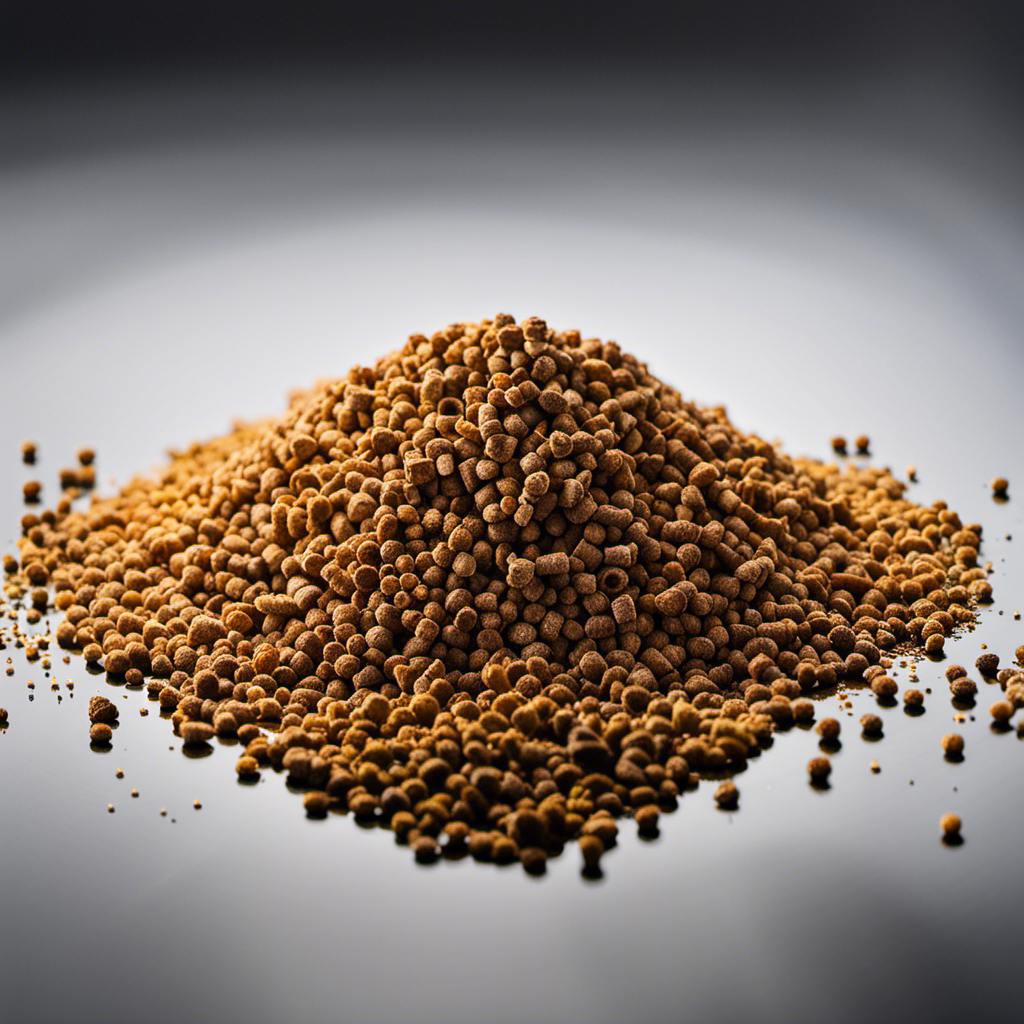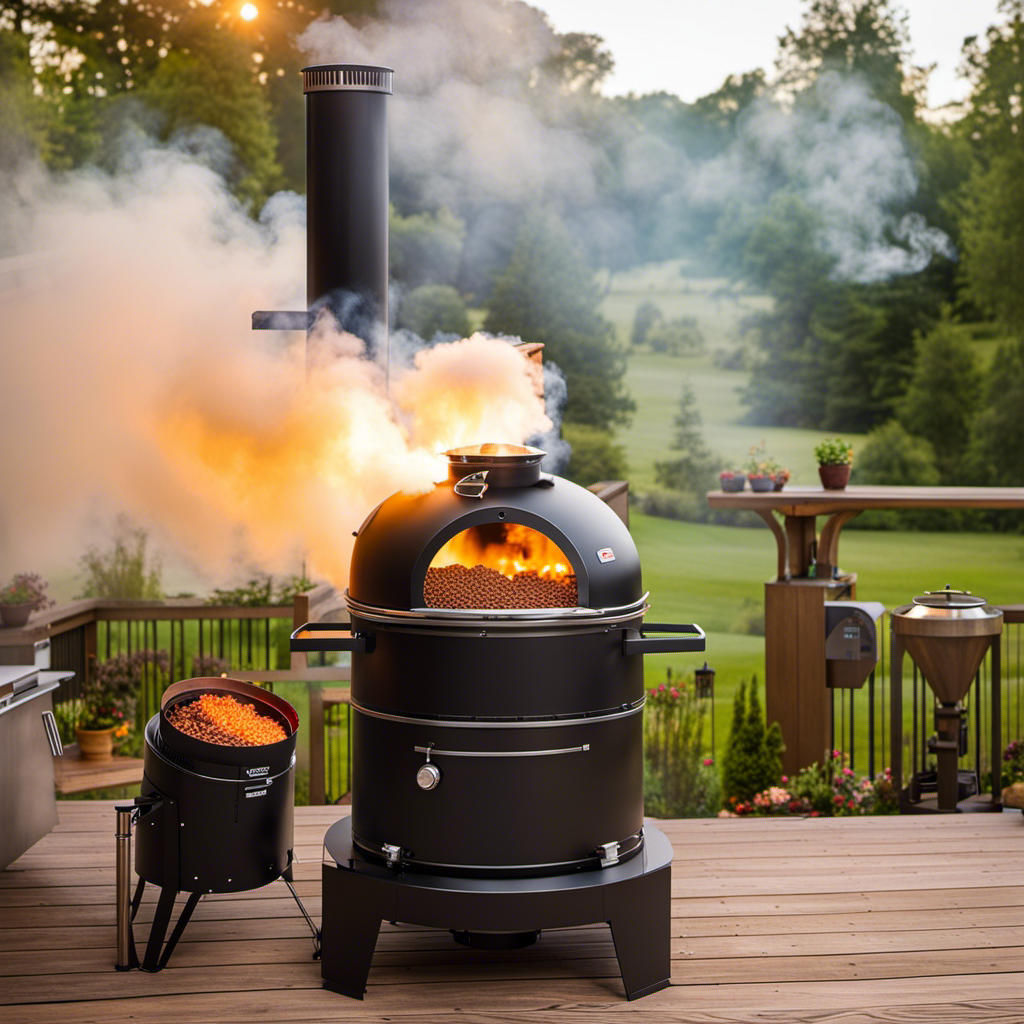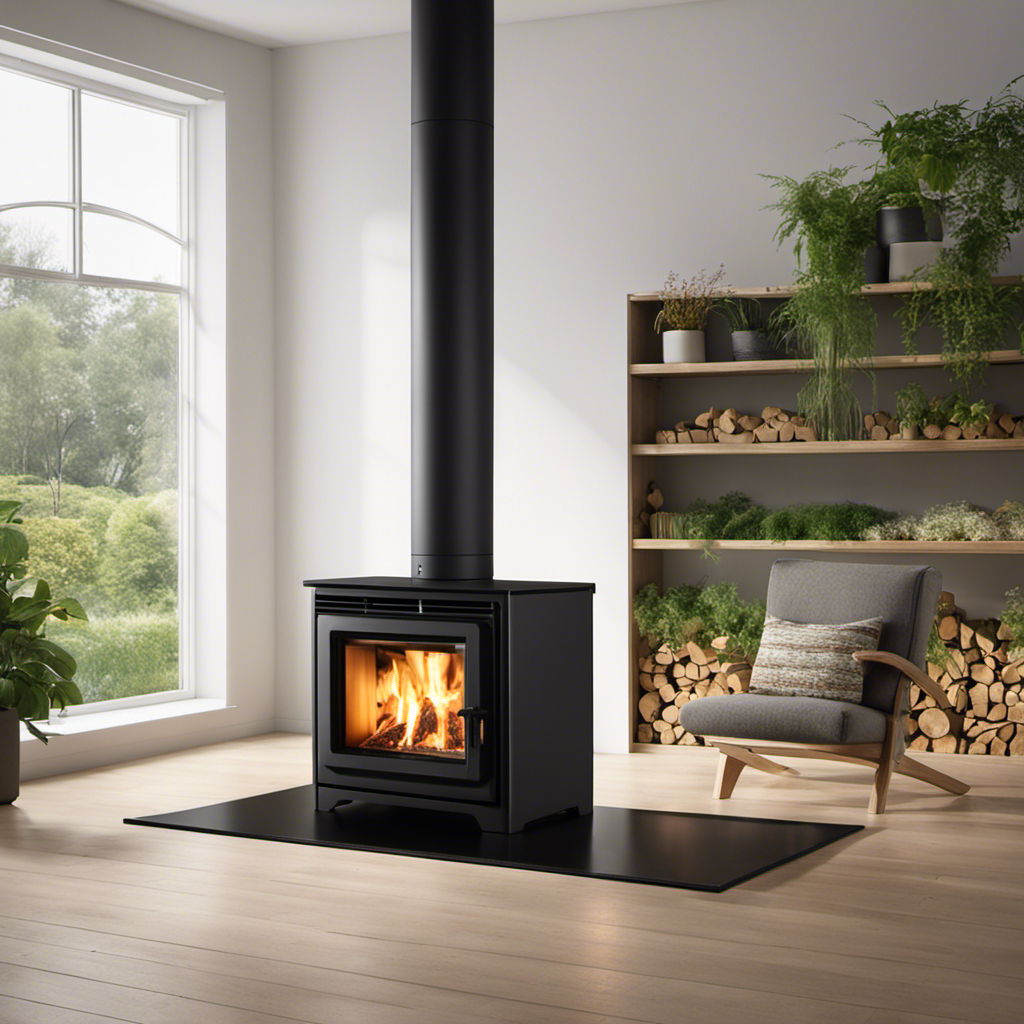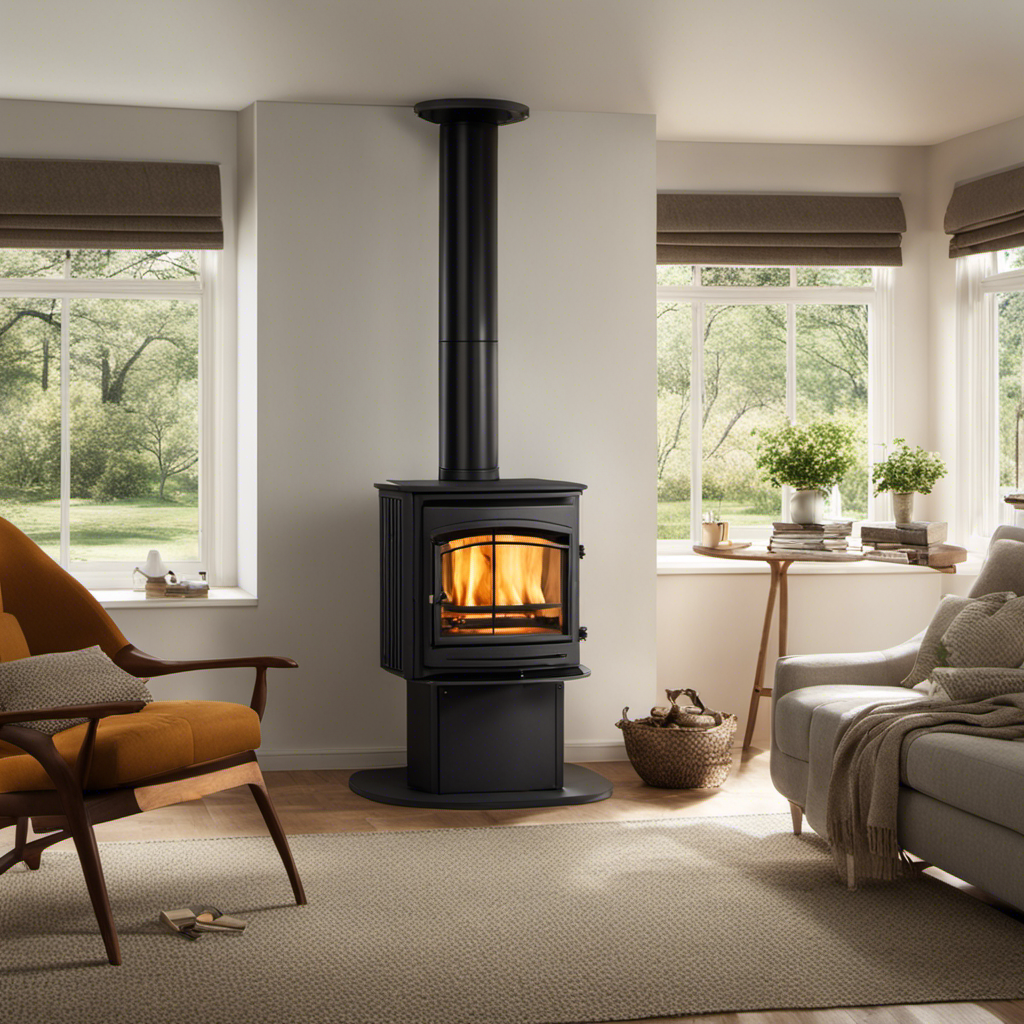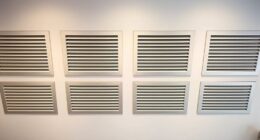As a person deeply passionate about wood pellets, I constantly search for the highest quality in my fuel. Achieving the ideal moisture content in wood pellets is crucial for igniting flawless flames and achieving optimal energy efficiency.
In this article, I will delve into the various techniques to accurately assess moisture levels in wood pellets. Through visual inspection, touch and feel, weight and density measurements, clumping or sticking together tests, odor analysis, color examination, and moisture content testing, we will unravel the secrets behind identifying damp wood pellets.
Key Takeaways
- Visual inspection methods such as discoloration, dark spots, and visible mold growth can indicate if a wood pellet is damp.
- Touch examination can help identify damp wood pellets by their soft and spongy texture, sticking together or leaving residue on fingers, and feeling cooler to the touch.
- Moisture content testing with moisture meters and evaluating absorption rate through controlled experiments are important for assessing wood pellet quality and performance.
- Clumping or sticking together of wood pellets, as well as the presence of a musty odor, can be indicators of moisture issues.
Visual Inspection
To visually inspect your wood pellet for dampness, simply look for any discoloration or mold growth. A visual examination is an effective method to assess the moisture level of the pellet. Start by examining the surface of the pellet closely. Look for any signs of discoloration, which may indicate moisture absorption. Discoloration can manifest as dark spots or patches on the surface. Additionally, check for any visible mold growth on the pellet. Mold thrives in moist environments, and its presence suggests high humidity levels or exposure to water. If you observe any discoloration or mold growth, it is likely that your wood pellet has absorbed moisture and is damp. This visual assessment will provide valuable insights before moving on to the touch and feel examination for further confirmation of dampness.
Transitioning into the subsequent section about ‘touch and feel,’ evaluating the physical properties of a wood pellet can also provide important information regarding its moisture content without relying solely on visual cues.
Touch and Feel
When feeling the wood pellet, you can quickly determine if it’s damp. Moisture detection is crucial in ensuring the quality of wood pellets, as excessive moisture can lead to issues like mold growth and combustion problems. To detect moisture through touch and feel, follow these steps:
- Texture: Damp wood pellets feel soft and spongy due to the increased water content.
- Stickiness: Moist pellets tend to stick together or leave a residue on your fingers when touched.
- Coolness: Wet pellets often feel cooler to the touch compared to dry ones.
To prevent such issues, proper drying methods are essential. This includes using specialized equipment like dryers or implementing natural drying techniques such as air-drying and sunlight exposure. By ensuring that wood pellets are properly dried, their overall performance and efficiency can be maximized.
Moving on from moisture detection, let’s now discuss how weight and density play a vital role in determining the quality of wood pellets without compromising combustion efficiency.
Weight and Density
When it comes to assessing the quality of wood pellets, there are several key points to consider.
First, moisture content testing is crucial in determining the level of water present in the pellets. This information helps ensure optimal combustion and prevents issues such as mold or degradation.
Second, absorption rate evaluation examines how quickly the pellets absorb moisture from their surroundings, which can impact their overall performance and shelf life.
Finally, visual inspection methods allow for a detailed analysis of the pellet’s appearance, including any signs of damage or irregularities that may affect its quality.
Moisture Content Testing
You can use a moisture meter to quickly determine if a wood pellet is damp. Moisture content measurement is an important factor in assessing the quality of wood pellets, as excessive moisture can lead to combustion issues and decreased energy efficiency.
When it comes to moisture testing techniques, here are three key methods:
-
Resistance-based moisture meters: These meters measure electrical resistance through two pins inserted into the wood pellet. The higher the resistance, the drier the pellet.
-
Capacitance-based moisture meters: These meters use electrical capacitance to measure the water content in wood pellets. They provide accurate results across a wide range of moisture levels.
-
Microwave-based moisture meters: These meters emit microwave radiation and analyze its interaction with water molecules in the pellet, providing instant readings.
Absorption Rate Evaluation
To evaluate the absorption rate of wood pellets, it’s important to consider the time it takes for the pellets to reach their maximum moisture content. This information can provide valuable insights into the accuracy of absorption rate measurements. There are alternative evaluation methods that can be used to determine the absorption rate with greater precision and reliability.
One such method is through conducting controlled experiments where wood pellets are exposed to a specific amount of moisture over a defined period. By measuring the weight gain of the pellets at regular intervals, we can calculate the absorption rate accurately.
Here is an example table showcasing how different wood pellet samples absorb moisture over time:
| Time (hours) | Sample A (%) | Sample B (%) |
|---|---|---|
| 0 | 0 | 0 |
| 1 | 2 | 1 |
| 2 | 4 | 3 |
| 3 | 6 | 5 |
| 4 | 8 | 7 |
Visual Inspection Methods
During my analysis of wood pellets, I found that visual inspection methods can also provide valuable insights into their moisture levels. By visually examining the pellets, one can identify any visible signs of dampness or water absorption.
Moisture level analysis involves assessing the appearance and texture of the pellets. If they appear discolored, darker than usual, or have a glossy surface, it may indicate high moisture content. Additionally, if the pellets feel soft or crumbly to touch, it suggests excessive water absorption.
These visual cues are essential for evaluating the water content in wood pellets and ensuring their quality and performance.
Now let’s move on to another aspect to consider when determining if wood pellets are damp: clumping or sticking together.
Clumping or Sticking Together
When wood pellets are damp, they tend to clump or stick together. This is a common issue that can affect the quality and performance of wood pellets.
Clumping analysis is an important step in moisture detection as it helps determine if the pellets have absorbed excess moisture. Here are four key factors to consider when analyzing clumping:
- Size and shape: Damp wood pellets often lose their uniformity and become irregular in size and shape.
- Color change: Moisture can cause discoloration, making the pellets darker or even moldy-looking.
- Density: Wet pellets tend to be denser than dry ones due to water absorption.
- Texture: When touched, damp wood pellets may feel sticky or mushy compared to dry ones.
It’s crucial to identify these signs of clumping as they indicate potential moisture issues in the pellets.
Transitioning into the subsequent section about odor or musty smell, one should also consider another aspect of pellet dampness.
Odor or Musty Smell
After examining whether wood pellets clump or stick together, another way to determine if they are damp is by detecting any odor or musty smell. When wood pellets contain moisture, they can develop a distinct smell that differs from the typical woody aroma. This odor is caused by the decomposition of organic matter due to high moisture levels. To assess the presence of this smell, you can use your sense of smell directly or perform an olfactory test by placing a small amount of pellets near your nose and inhaling gently. If a strong musty odor is detected, it indicates that the wood pellets have absorbed moisture and may not burn efficiently. By using odor detection and estimating moisture levels in this manner, you can confidently identify damp wood pellets.
| Method | Pros | Cons |
|---|---|---|
| Direct smelling | Quick and easy | Subjective interpretation |
| Olfactory test | Controlled evaluation | Requires close proximity |
Transitioning into the subsequent section about ‘color and appearance’, we move on to another visual indicator that helps us determine if wood pellets are damp without relying solely on our sense of smell.
Color and Appearance
To determine if your wood pellets have absorbed moisture, simply look for any changes in color and appearance. Wood pellets that are damp will often exhibit a darker or discolored hue compared to dry ones. The visual appeal of the pellets may be compromised as well, with a dull or lackluster appearance. Moisture detection is crucial as it can affect the performance and efficiency of your pellet stove or boiler.
When wood pellets absorb moisture, they become less dense and won’t burn properly, leading to reduced heat output and increased emissions. Therefore, regularly inspecting the color and appearance of your wood pellets is essential to ensure their quality and effectiveness.
Transitioning into the subsequent section about moisture content testing:
Now that we have examined how to visually detect moisture in wood pellets, let’s explore another method – testing their moisture content.
Moisture Content Testing
Now that we’ve covered visual detection of moisture, let’s delve into another method – testing the moisture content of wood pellets.
Moisture level measurement is crucial in ensuring the quality and efficiency of wood pellet combustion. When wood pellets contain excessive moisture, they tend to burn inefficiently, leading to lower heat output and increased emissions.
To accurately determine the moisture content, various drying techniques can be employed. One common method is using a moisture meter specifically designed for wood pellets. These meters utilize electrical resistance or capacitance principles to measure the amount of water present in the pellets. By obtaining accurate measurements, appropriate steps can then be taken to reduce the moisture content if necessary. This ultimately contributes to improved burn quality and efficiency during pellet combustion.
Transitioning into the subsequent section on ‘burn quality and efficiency,’ it is important to understand how these factors are influenced by both pellet composition and stove operation.
Burn Quality and Efficiency
When it comes to burn quality and efficiency, there are several key points to consider.
First, the moisture content of wood pellets can have a significant impact on their combustion performance. High moisture content can lead to incomplete combustion and reduced heat output.
Second, combustion performance indicators such as ash content and emissions levels can provide valuable insights into the efficiency of the burning process. Monitoring these indicators allows for adjustments to optimize performance and minimize environmental impact.
Lastly, maximizing energy efficiency involves factors such as proper stove maintenance, using high-quality fuel with optimal moisture content, and ensuring efficient airflow during combustion.
Moisture Content’s Effect
You can easily determine if a wood pellet is damp by checking its moisture content. The moisture content of a wood pellet has a significant impact on its burn quality and efficiency. Pellets with high moisture content tend to produce more smoke and ash, which can lead to poor combustion performance.
To ensure optimal burn quality, it is important to choose pellets that have been properly dried and have a low moisture content. There are several drying methods used in the production of wood pellets, including natural air drying, kiln drying, and steam drying. Each method has its advantages and disadvantages in terms of cost, time, and effectiveness.
Combustion Performance Indicators
To gauge the efficiency of burning wood pellets, it’s essential to consider various indicators of combustion performance. These indicators provide valuable insight into the burning efficiency and help determine whether the moisture content of the pellets is within an optimal range.
Key indicators include:
-
Flame characteristics: A well-combusted pellet produces a steady and bright flame, indicating efficient fuel utilization.
-
Ash content: Lower ash content suggests better combustion, as excessive ash can clog up the system and reduce heat transfer.
-
Carbon monoxide emissions: Monitoring CO levels during burning helps assess combustion completeness and efficiency.
Maximizing Energy Efficiency
In order to maximize energy efficiency and reduce energy consumption, it is important to consider several factors when using wood pellets as a fuel source.
Firstly, ensuring that the wood pellets are of high quality and free from dampness is crucial. Damp wood pellets have higher moisture content, which leads to decreased combustion efficiency and increased emissions. To prevent this, it is recommended to store wood pellets in dry conditions and avoid exposure to moisture.
Secondly, optimizing the combustion process can also help maximize energy efficiency. This can be achieved by properly adjusting the air-to-fuel ratio and ensuring adequate airflow in the combustion system.
By implementing these measures, we can ensure that wood pellets are utilized effectively as a renewable energy source.
Moving on to storage conditions and packaging…
Storage Conditions and Packaging
Check if the wood pellet packaging has any signs of damage or moisture. This is important because it indicates whether the pellets have been exposed to moisture, which can affect their quality and performance. Moisture can cause the pellets to clump together, making them difficult to ignite and burn efficiently. It can also lead to mold growth, which poses health risks when burned.
To ensure optimal storage conditions for wood pellets, consider the following:
-
Storage temperature: Wood pellets should be stored in a dry place with a stable temperature between 40-70 degrees Fahrenheit.
-
Moisture-proof packaging: Look for wood pellet bags that are made from moisture-resistant materials such as plastic or laminated paper. These types of packaging provide an extra layer of protection against moisture infiltration.
-
Proper ventilation: Allow adequate airflow around the stored wood pellets to prevent condensation and reduce the risk of moisture buildup.
Following these guidelines will help maintain the quality and effectiveness of your wood pellets for long-term storage and use.
Frequently Asked Questions
Can I Use Damp Wood Pellets in My Pellet Stove or Boiler?
I wouldn’t recommend using damp wood pellets in your pellet stove or boiler. The moisture content of wood pellets should be low for optimal burning efficiency. Wet pellets could lead to poor combustion and potential damage to your equipment.
How Long Do Wood Pellets Typically Take to Dry Out if They Are Damp?
Wood pellets typically take anywhere from a few hours to a couple of days to dry out if they are damp. Signs of moisture in wood pellets include clumping, discoloration, and a musty smell. Wood pellet drying methods involve using heat and airflow to remove the moisture content.
Are There Any Health Risks Associated With Burning Damp Wood Pellets?
There can be health risks associated with burning damp wood pellets. Combustion efficiency is reduced, leading to incomplete combustion and the release of harmful pollutants like carbon monoxide.
Can Damp Wood Pellets Cause Damage to My Pellet Stove or Boiler?
Damp wood pellets can cause damage to pellet stoves or boilers. When burned, they produce excess moisture and can clog the system. Properly storing wood pellets in a dry environment is crucial to prevent dampness.
How Can I Prevent Wood Pellets From Getting Damp During Storage?
To prevent moisture absorption and keep wood pellets dry during storage, I recommend using moisture-proof storage containers. These containers create a barrier that prevents any dampness from reaching the pellets, ensuring their quality and performance.
Conclusion
In conclusion, when it comes to determining if a wood pellet is damp, one must rely on their senses and employ various methods of inspection.
Just as a seasoned sailor navigates the treacherous seas using their intuition and experience, so too must we navigate the world of wood pellets.
By visually inspecting for clumping and discoloration, touching for moisture or stickiness, weighing for density, and testing for burn quality, we can ensure our pellets are dry and efficient.
Remember to store them in optimal conditions to maintain their integrity.

